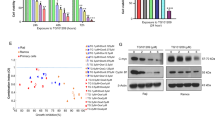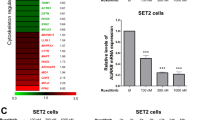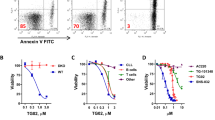Abstract
Janus kinases (JAKs) are involved in various signalling pathways exploited by malignant cells. In multiple myeloma (MM), the interleukin-6/JAK/signal transducers and activators of transcription (IL-6/JAK/STAT) pathway has been the focus of research for a number of years and IL-6 has an established role in MM drug resistance. JAKs therefore make a rational drug target for anti-MM therapy. CYT387 is a novel, orally bioavailable JAK1/2 inhibitor, which has recently been described. This preclinical evaluation of CYT387 for treatment of MM demonstrated that CYT387 was able to prevent IL-6-induced phosphorylation of STAT3 and greatly decrease IL-6- and insulin-like growth factor-1-induced phosphorylation of AKT and extracellular signal-regulated kinase in human myeloma cell lines (HMCL). CYT387 inhibited MM proliferation in a time- and dose-dependent manner in 6/8 HMCL, and this was not abrogated by the addition of exogenous IL-6 (3/3 HMCL). Cell cycling was inhibited with a G2/M accumulation of cells, and apoptosis was induced by CYT387 in all HMCL tested (3/3). CYT387 synergised in killing HMCL when used in combination with the conventional anti-MM therapies melphalan and bortezomib. Importantly, apoptosis was also induced in primary patient MM cells (n=6) with CYT387 as a single agent, and again synergy was seen when combined with conventional therapies.
This is a preview of subscription content, access via your institution
Access options
Subscribe to this journal
Receive 12 print issues and online access
$259.00 per year
only $21.58 per issue
Buy this article
- Purchase on Springer Link
- Instant access to full article PDF
Prices may be subject to local taxes which are calculated during checkout





Similar content being viewed by others
References
Kralovics R, Passamonti F, Buser AS, Teo SS, Tiedt R, Passweg JR et al. A gain-of-function mutation of JAK2 in myeloproliferative disorders. N Engl J Med 2005; 352: 1779–1790.
Levine RL, Wadleigh M, Cools J, Ebert BL, Wernig G, Huntly BJ et al. Activating mutation in the tyrosine kinase JAK2 in polycythemia vera, essential thrombocythemia, and myeloid metaplasia with myelofibrosis. Cancer cell 2005; 7: 387–397.
Scott LM, Tong W, Levine RL, Scott MA, Beer PA, Stratton MR et al. JAK2 exon 12 mutations in polycythemia vera and idiopathic erythrocytosis. N Engl J Med 2007; 356: 459–468.
Mullighan CG, Zhang J, Harvey RC, Collins-Underwood JR, Schulman BA, Phillips LA et al. JAK mutations in high-risk childhood acute lymphoblastic leukemia. Proc Natl Acad SciUSA 2009; 106: 9414–9418.
Rane SG, Reddy EP . Janus kinases: components of multiple signaling pathways. Oncogene 2000; 19: 5662–5679.
French JD, Walters DK, Jelinek DF . Transactivation of gp130 in myeloma cells. J Immunol 2003; 170: 3717–3723.
Berger LC, Hawley TS, Lust JA, Goldman SJ, Hawley RG . Tyrosine phosphorylation of JAK-TYK kinases in malignant plasma cell lines growth-stimulated by interleukins 6 and 11. Biochem Biophys Res Commun 1994; 202: 596–605.
Gomez-Benito M, Balsas P, Carvajal-Vergara X, Pandiella A, Anel A, Marzo I et al. Mechanism of apoptosis induced by IFN-alpha in human myeloma cells: role of Jak1 and Bim and potentiation by rapamycin. Cell Signal 2007; 19: 844–854.
Jelinek DF, Ahmann GJ, Greipp PR, Jalal SM, Westendorf JJ, Katzmann JA et al. Coexistence of aneuploid subclones within a myeloma cell line that exhibits clonal immunoglobulin gene rearrangement: clinical implications. Cancer Res 1993; 53: 5320–5327.
Zhang XG, Gaillard JP, Robillard N, Lu ZY, Gu ZJ, Jourdan M et al. Reproducible obtaining of human myeloma cell lines as a model for tumor stem cell study in human multiple myeloma. Blood 1994; 83: 3654–3663.
Cheung WC, Van Ness B . The bone marrow stromal microenvironment influences myeloma therapeutic response in vitro. Leukemia 2001; 15: 264–271.
Moreaux J, Legouffe E, Jourdan E, Quittet P, Reme T, Lugagne C et al. BAFF and APRIL protect myeloma cells from apoptosis induced by interleukin 6 deprivation and dexamethasone. Blood 2004; 103: 3148–3157.
Perez LE, Parquet N, Shain K, Nimmanapalli R, Alsina M, Anasetti C et al. Bone marrow stroma confers resistance to Apo2 ligand/TRAIL in multiple myeloma in part by regulating c-FLIP. J Immunol 2008; 180: 1545–1555.
Klein B, Zhang XG, Jourdan M, Content J, Houssiau F, Aarden L et al. Paracrine rather than autocrine regulation of myeloma-cell growth and differentiation by interleukin-6. Blood 1989; 73: 517–526.
Hata H, Xiao H, Petrucci MT, Woodliff J, Chang R, Epstein J . Interleukin-6 gene expression in multiple myeloma: a characteristic of immature tumor cells. Blood 1993; 81: 3357–3364.
Tyner JW, Bumm TG, Deininger J, Wood L, Aichberger KJ, Loriaux MM et al. CYT387, a novel JAK2 inhibitor, induces hematologic responses and normalizes inflammatory cytokines in murine myeloproliferative neoplasms. Blood 2010; 115: 5232–5240.
Pardanani A, Lasho T, Smith G, Burns CJ, Fantino E, Tefferi A . CYT387, a selective JAK1/JAK2 inhibitor: in vitro assessment of kinase selectivity and preclinical studies using cell lines and primary cells from polycythemia vera patients. Leukemia 2009; 23: 1441–1445.
Burns CJ, Bourke DG, Andrau L, Bu X, Charman SA, Donohue AC et al. Phenylaminopyrimidines as inhibitors of Janus kinases (JAKs). Bioorg Med Chem Lett 2009; 19: 5887–5892.
Burger R, Le Gouill S, Tai YT, Shringarpure R, Tassone P, Neri P et al. Janus kinase inhibitor INCB20 has antiproliferative and apoptotic effects on human myeloma cells in vitro and in vivo. Mol Cancer Ther 2009; 8: 26–35.
Li J, Favata M, Kelley JA, Caulder E, Thomas B, Wen X et al. INCB16562, a JAK1/2 selective inhibitor, is efficacious against multiple myeloma cells and reverses the protective effects of cytokine and stromal cell support. Neoplasia (New York, NY) 2010; 12: 28–38.
De Vos J, Jourdan M, Tarte K, Jasmin C, Klein B . JAK2 tyrosine kinase inhibitor tyrphostin AG490 downregulates the mitogen-activated protein kinase (MAPK) and signal transducer and activator of transcription (STAT) pathways and induces apoptosis in myeloma cells. Br J Haematol 2000; 109: 823–828.
Alas S, Bonavida B . Inhibition of constitutive STAT3 activity sensitizes resistant non-Hodgkin's lymphoma and multiple myeloma to chemotherapeutic drug-mediated apoptosis. Clin Cancer Res 2003; 9: 316–326.
Scuto A, Krejci P, Popplewell L, Wu J, Wang Y, Kujawski M et al. The novel JAK inhibitor AZD1480 blocks STAT3 and FGFR3 signaling, resulting in suppression of human myeloma cell growth and survival. Leukemia 2011; 25: 538–550.
Pedranzini L, Dechow T, Berishaj M, Comenzo R, Zhou P, Azare J et al. Pyridone 6, a pan-Janus-activated kinase inhibitor, induces growth inhibition of multiple myeloma cells. Cancer Res 2006; 66: 9714–9721.
Ferrajoli A, Faderl S, Van Q, Koch P, Harris D, Liu Z et al. WP1066 disrupts Janus kinase-2 and induces caspase-dependent apoptosis in acute myelogenous leukemia cells. Cancer Res 2007; 67: 11291–11299.
Pardanani A, George G, Lasho T, Hogan WJ, Litzow MR, Begna K et al. A Phase I/II Study of CYT387, An Oral JAK-1/2 Inhibitor, In Myelofibrosis: Significant Response Rates In Anemia, Splenomegaly, and Constitutional Symptoms. Blood; 52nd ASH Annual Meeting and Exposition 6/12/2010; Orlando, Florida, USA, 116. Abstract 460. p. 206.
Khong T, Sharkey J, Spencer A . The effect of azacitidine on interleukin-6 signaling and nuclear factor-kappaB activation and its in vitro and in vivo activity against multiple myeloma. Haematologica 2008; 93: 860–869.
Monaghan K, Khong T, Smith G, Spencer A . CYT997 Causes apoptosis in human multiple myeloma. Invest New Drugs 2011; 29: 232–238.
Zong CS, Chan J, Levy DE, Horvath C, Sadowski HB, Wang LH . Mechanism of STAT3 activation by insulin-like growth factor I receptor. J Biol Chem 2000; 275: 15099–15105.
Gual P, Baron V, Lequoy V, Van Obberghen E . Interaction of Janus kinases JAK-1 and JAK-2 with the insulin receptor and the insulin-like growth factor-1 receptor. Endocrinology 1998; 139: 884–893.
Chatterjee M, Stuhmer T, Herrmann P, Bommert K, Dorken B, Bargou RC . Combined disruption of both the MEK/ERK and the IL-6R/STAT3 pathways is required to induce apoptosis of multiple myeloma cells in the presence of bone marrow stromal cells. Blood 2004; 104: 3712–3721.
Kumar S, Rajkumar SV, Kimlinger T, Greipp PR, Witzig TE . CD45 expression by bone marrow plasma cells in multiple myeloma: clinical and biological correlations. Leukemia 2005; 19: 1466–1470.
Thabard W, Collette M, Mellerin MP, Puthier D, Barille S, Bataille R et al. IL-6 upregulates its own receptor on some human myeloma cell lines. Cytokine 2001; 14: 352–356.
Puthier D, Bataille R, Amiot M . IL-6 up-regulates mcl-1 in human myeloma cells through JAK / STAT rather than ras/MAP kinase pathway. Eur J Immunol 1999; 29: 3945–3950.
Chatterjee M, Honemann D, Lentzsch S, Bommert K, Sers C, Herrmann P et al. In the presence of bone marrow stromal cells human multiple myeloma cells become independent of the IL-6/gp130/STAT3 pathway. Blood 2002; 100: 3311–3318.
Ferlin M, Noraz N, Hertogh C, Brochier J, Taylor N, Klein B . Insulin-like growth factor induces the survival and proliferation of myeloma cells through an interleukin-6-independent transduction pathway. Br J Haematol 2000; 111: 626–634.
Acknowledgements
CYT387 was kindly provided by YM BioSciences, Australia. This study was supported by part funding from the Multiple Myeloma Research Foundation.
Author information
Authors and Affiliations
Corresponding author
Ethics declarations
Competing interests
Katherine A Monaghan, Tiffany Khong and Andrew Spencer declare no potential conflict of interest. Christopher J Burns is an employee of YM BioSciences, and holds equity in the company.
Additional information
Supplementary Information accompanies the paper on the Leukemia website
Supplementary information
Rights and permissions
About this article
Cite this article
Monaghan, K., Khong, T., Burns, C. et al. The novel JAK inhibitor CYT387 suppresses multiple signalling pathways, prevents proliferation and induces apoptosis in phenotypically diverse myeloma cells. Leukemia 25, 1891–1899 (2011). https://doi.org/10.1038/leu.2011.175
Received:
Accepted:
Published:
Issue Date:
DOI: https://doi.org/10.1038/leu.2011.175
Keywords
This article is cited by
-
Design, Synthesis and Bioactivity Study of Marine Alkaloid Neobacillamide—A Derivatives
Journal of Ocean University of China (2023)
-
EGFR transcriptionally upregulates UTX via STAT3 in non-small cell lung cancer
Journal of Cancer Research and Clinical Oncology (2022)
-
The JAK/STAT signaling pathway: from bench to clinic
Signal Transduction and Targeted Therapy (2021)
-
Citarinostat and Momelotinib co-target HDAC6 and JAK2/STAT3 in lymphoid malignant cell lines: a potential new therapeutic combination
Apoptosis (2020)
-
Management and outcomes of proteasome inhibitor associated chalazia and blepharitis: a case series
BMC Ophthalmology (2019)



